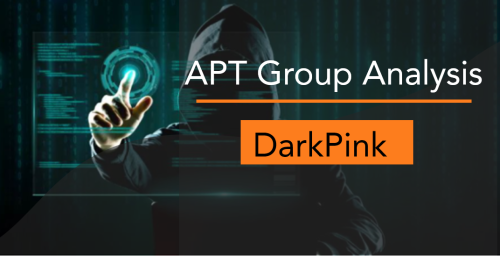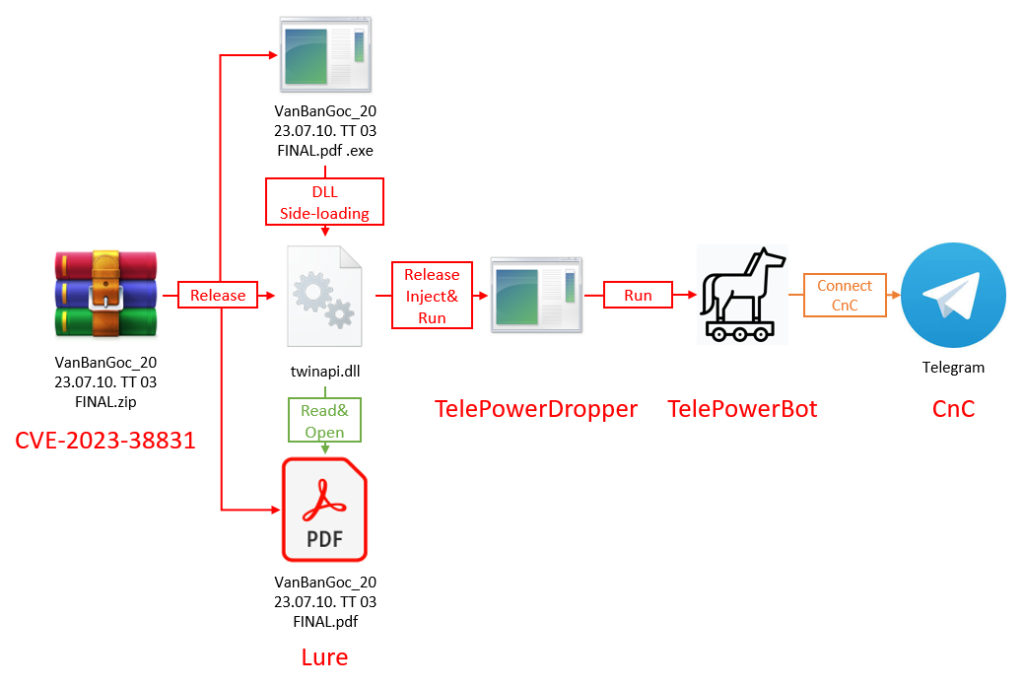
Overview
NSFOCUS Security Labs has been continuously monitoring the newly discovered WinRAR 0-day vulnerability, CVE-2023-38831. It has come to our attention that the advanced persistent threat group known as DarkPink has recently begun exploiting this vulnerability to target government entities in Vietnam and Malaysia.
In this round of attack activities, DarkPink attackers have incorporated the CVE-2023-38831 vulnerability into their existing attack processes, making several enhancements to their attack tactics, which has significantly increased their success rate.
This report will analyze DarkPink’s enhanced attack process and tactics.
Introduction to DarkPink
DarkPink, also known as Saaiwc, is a newly identified APT group confirmed in January 2023. The organization initially became active in mid-2021 and primarily targets entities in the Asia-Pacific region. Their main targets include diplomatic, military, and various industries in countries such as Cambodia, Indonesia, Malaysia, the Philippines, Vietnam, Bosnia and Herzegovina, and others. DarkPink’s primary method of attack involves spear-phishing, delivering their homemade Trojan programs, TelePowerBot and KamiKakaBot, through email to conduct network espionage activities.
Baits Used by DarkPink
In this recent cyberattack campaign, DarkPink employed various baits, all in the form of PDF files, which were placed within WinRAR vulnerability files to entice users to open and view them. One of these baits is named “VanBanGoc_2023.07.10. TT 03 FINAL”, a legal document bearing the letterhead of the Vietnamese Ministry of Foreign Affairs, as shown in the figure below:
Another bait is named “Ủy ban Chứng khoán Nhà nước thông báo tuyển dụng công chức năm 2023” (Announcement from the State Securities Commission for the recruitment of civil servants in 2023). This file originates from the State Securities Commission of Vietnam, as shown in the figure below:
Another bait is named “TTBC số 37 về Quỹ BOG quý II2023” (Document No. 37 regarding the BOG Fund in the second quarter of 2023). This document is news information released by the Ministry of Finance of Vietnam regarding the Petroleum Price Stabilization Fund (BOG), as shown below:
There is another bait file named ‘Keputusan Permohonan Mendapatkan Perkhidmatan Penceramah Luar Untuk Program Anjuran Kementerian Pertahanan’ (Decision on the Application to Obtain External Speaker Services for the Ministry of Defence’s Organized Program). This is also a government document with the letterhead of the Department of Strategic Planning and Policy of the Malaysian Ministry of Defence, as shown in the figure below:

It’s evident that the primary targets of DarkPink’s current attack campaign are the governments of Vietnam and Malaysia. The bait files used in this campaign follow the group’s consistent approach of using genuine-looking government documents to enhance the deception of the baits. Coupled with the newly used WinRAR vulnerability exploitation, this makes it difficult for victims to detect that they have fallen victim to an attack.
Attack Process of DarkPink in this Campaign
In this campaign, DarkPink employed an enhanced process that combines their classic attack methodology with the exploitation of the CVE-2023-38831 vulnerability, as shown below:

Vulnerability Exploitation Phase
The CVE-2023-38831 vulnerability exploitation file constructed by DarkPink is as follows, including a PDF bait file and a folder with the same name:
Inside the folder, there are two files: one is an exe program with the same name as the PDF bait file, and the other is a library file named ‘twinapi.dll’:
When a user attempts to open the PDF bait file in a lower version of WinRAR, the CVE-2023-38831 vulnerability exploitation is triggered, leading to the execution of the exe program within the folder.
Trojan Deployment Phase
In fact, the exe program executed when triggered by CVE-2023-38831 is the Windows system application explorer.exe. During its execution, it attempts to load the twinapi.dll file located in the same directory, creating a side-loading exploitation attack pattern.
The twinapi.dll is a loader-type Trojan specially developed by DarkPink for this campaign. The main function of this Trojan is to extract a portion of data from the PDF bait file, decrypt one of the embedded PE files, and inject it into the parent process.
The loaded PE file is DarkPink’s typical loader-type Trojan program, TelePowerDropper, which ultimately implants the remote control Trojan program, TelePowerBot, on the victim’s host.
Analysis of Techniques and Tactics Used by DarkPink
Given that in this campaign DarkPink has continued to employ its previously used attack approach, this report will focus on the techniques and tactics that have been newly added or modified by the APT group this time.
Execution – User Execution – Malicious File
CVE-2023-38831 Exploitation
In this attack campaign, the most significant change in DarkPink’s tactics and techniques is the transformation of the initial malicious file into a CVE-2023-38831 vulnerability exploitation file.
In previous attack campaigns, DarkPink attackers used ISO files as the initial bait, hoping that victims would directly run the executable file with a disguised filename after opening the ISO file, thereby triggering the entire execution process. A typical bait used by DarkPink in previous attack campaigns is shown in the figure below:
This is a classic method of disguised execution, but its drawback lies in exposing the executable file extension, making it challenging to deceive vigilant victims.
In this attack campaign, the CVE-2023-38831 vulnerability significantly enhances the deception of the initial malicious file. Victims trigger the attack process when viewing the malicious file with WinRAR software, as shown in the figure below.
Unless they have a certain understanding of this vulnerability, victims have almost no defense against this attack method, greatly increasing DarkPink’s success rate in this campaign.
Persistence – Event Triggered Execution – Changing Default File Association
Malicious code triggered by amv files
In this attack campaign, DarkPink attackers gained the ability to run malicious cmd commands stably on the victim’s host by modifying the default opening method for specific files. The specific implementation of this technique involves two steps.
First, DarkPink’s TelePowerDropper Trojan creates the following set of registry entries:
With this configuration, when Windows attempts to open .amv files, it triggers the malicious code in the registry entries (See the abuse of DelegateExecute in the next section for the triggering method).
In the second step, the TelePowerDropper Trojan creates an empty file named ‘Tsys.amv’ in the system’s Startup directory. This way, when the system starts up, it attempts to open this .amv file, triggering the subsequent execution process of the TelePowerBot Trojan.
Compared to previous attack processes, the enhancements in this campaign primarily focus on two key aspects.
Firstly, DarkPink changed the file type for the execution trigger from ‘.abcd’ to ‘.amv,’ reducing the likelihood of discovering DarkPink attack traces through a file extension search. Secondly, the improvement is seen in the specific triggering method, where DarkPink directly sets the startup file to trigger the execution instead of the previous method of writing cmd code in the registry’s UserInitMprLogonScript entry. This change also reduces the likelihood of discovering DarkPink attack traces by searching specific registry entries.
The enhancements to this attack technique aim to remove the characteristics of the technique exposed previously.
Defense Evasion – File or Information Obfuscation – Command Obfuscation
Splitting Registry Key Values
Another improvement by DarkPink in this campaign involves UAC bypass and Windows Defender evasion through the use of the DelegateExecute logic in the registry.
The TelePowerDropper Trojan used by DarkPink in this campaign creates the following registry key values under “HKEY_CURRENT_USER\Software\Classes\amvfile\shell\open\command\”.
The key difference in the key values written by the new TelePowerDropper Trojan in this campaign is the splitting of the malicious code that was originally all written into the Default value, and the use of Scriptrunner.exe as the launcher.
Additionally, the TelePowerDropper Trojan creates a key named ‘DelegateExecute,’ causing the Windows system to first check this key value when handling amv files before proceeding to execute the malicious command located under Default.
These changes make it more difficult to detect malicious code in the registry, and when combined with the CVE-2023-38831 vulnerability exploitation, they successfully bypass checks by Windows 10’s UAC and Windows Defender in practice.
Conclusion
The recent attack campaign launched by DarkPink shows that the WinRAR vulnerability CVE-2023-38831 has attracted great interest from APT groups. Since the disclosure of CVE-2023-38831, it has quickly become a favorite among various hacking groups, including APT groups. This was due to its one-click activation, compatibility with WinRAR software, ease of constructing the vulnerability, and effectiveness in facilitating phishing attacks. Using this vulnerability file as an attachment significantly increases the success rate of phishing attacks, and the difficulty in managing and updating WinRAR makes it challenging to eliminate the impact of this vulnerability exploitation.
Currently, the primary policy for defending against CVE-2023-38831 should focus on enhancing endpoint detection and response (EDR) capabilities. NSFOCUS Security Labs has observed various variants of CVE-2023-38831 vulnerability files, indicating that attackers are working on ways to reduce the detection rate of these files. It is expected the ongoing battle between cyberattacks and defense related to CVE-2023-38831 will persist.













